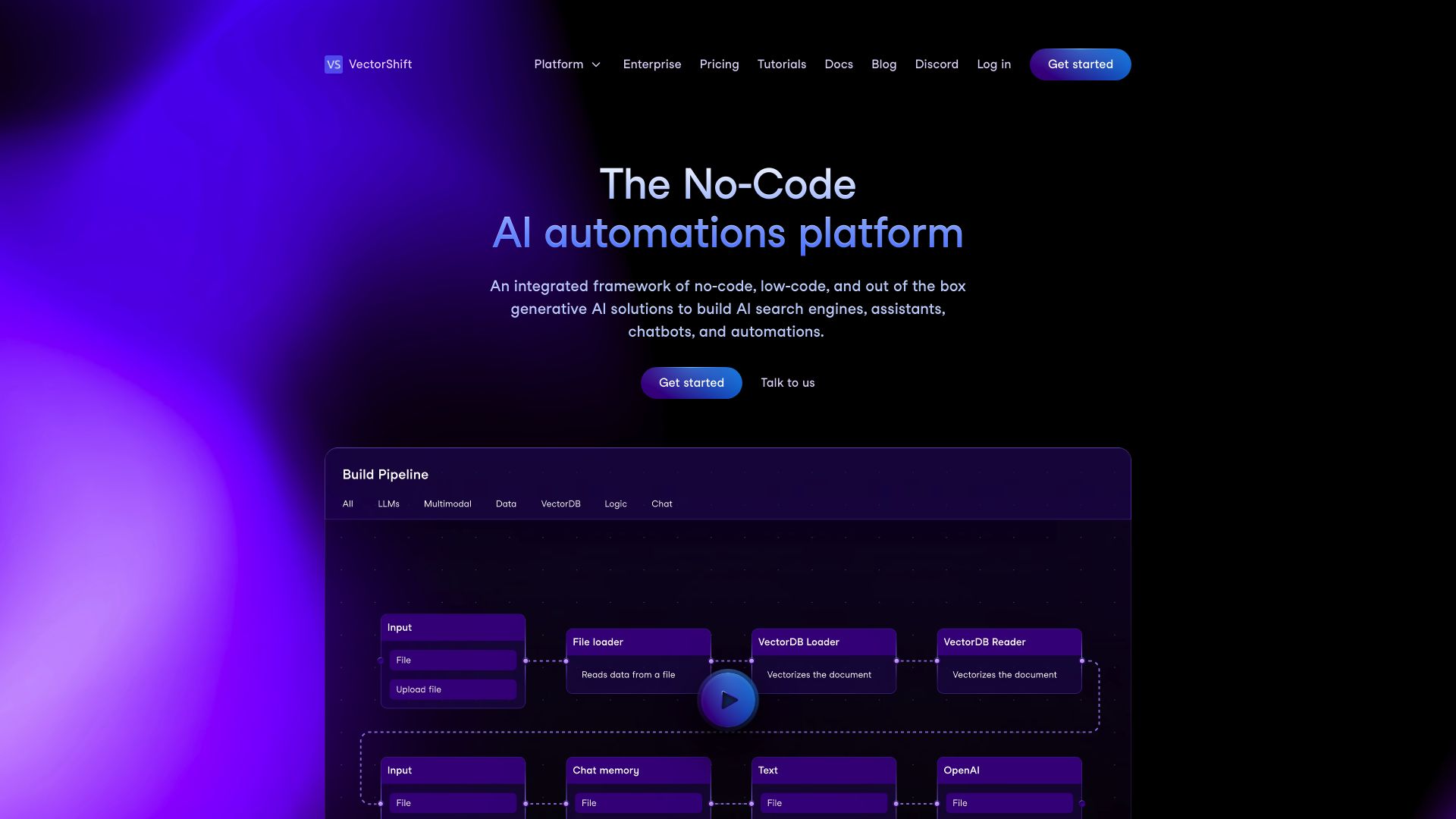AutoGPT vs. VectorShift: Comparing AI Agent Platforms
AI agent development platforms revolutionize how businesses leverage artificial intelligence. AutoGPT vs. VectorShift offer powerful solutions for creating autonomous AI agents and automating complex workflows. This comparison explores their unique approaches, strengths, and limitations.
We’ll examine how these platforms stack up against SmythOS, a comprehensive AI development environment that combines advanced features with user-friendly design. Whether you’re a seasoned developer or a business leader exploring AI integration, this analysis will help you navigate the landscape of AI agent builders and choose the solution that best fits your needs.
AutoGPT Overview
AutoGPT empowers developers to create autonomous AI agents capable of completing complex tasks without constant human input. This open-source platform leverages GPT-4 or GPT-3.5 APIs to build agents that self-prompt, break down goals into manageable steps, and execute them independently.


AutoGPT’s visual builder simplifies agent creation through a drag-and-drop interface, allowing users to construct AI workflows without extensive coding knowledge. The platform excels at task decomposition, maintaining short-term memory for context, and leveraging internet resources to achieve user-defined objectives.
AutoGPT empowers developers to create autonomous AI agents capable of completing complex tasks without constant human input.
Key features include multimodal input processing (text and images), debugging capabilities, and REST API integration. AutoGPT supports Docker deployment for scalability and offers OAuth authentication for secure access. These features make it suitable for diverse applications, from software development to content creation and market research.
While AutoGPT offers powerful autonomous capabilities, it faces challenges. The platform can be prone to errors due to self-feedback loops and lacks long-term memory, potentially affecting performance on extended tasks. Additionally, its recursive nature may lead to high operational costs.
AutoGPT represents a significant step towards artificial general intelligence (AGI), showcasing both the potential and limitations of current autonomous AI systems. Its open-source nature encourages community-driven innovation, making it an attractive option for developers and businesses exploring advanced AI applications.
VectorShift Overview
VectorShift empowers users to create and manage advanced AI workflows through its versatile platform. The software combines no-code and code SDK interfaces, catering to both technical experts and novice users. This dual approach democratizes AI development, allowing a wide range of professionals to harness the power of artificial intelligence.
At the core of VectorShift’s offering is its pipeline dashboard, where users can build AI workflows from scratch or leverage pre-built templates. This feature streamlines the development process, enabling rapid prototyping and deployment of AI solutions. The platform’s visual builder acts as a no-code editor, allowing users to drag and drop modular blocks to construct AI agents without extensive programming knowledge.
VectorShift empowers users to create and manage advanced AI workflows through its versatile platform. The software combines no-code and code SDK interfaces, catering to both technical experts and novice users.
VectorShift excels in its comprehensive automation capabilities. Users can create end-to-end automated workflows, schedule tasks, and trigger actions based on specific events. This functionality extends to various use cases, including chatbots, search functions, and content creation. The platform’s integration with multiple data sources, such as Google Drive, Slack, and Airtable, centralizes data management and facilitates live syncing across applications.


One of VectorShift’s standout features is its knowledge base, which performs semantic searches to enhance the accuracy and relevance of AI-generated responses. This capability proves particularly valuable for businesses seeking to leverage their existing data assets effectively. Additionally, the platform offers flexible deployment options, allowing users to implement their AI workflows as chatbots, automations, or search functions with various customization and export choices.
VectorShift excels in its comprehensive automation capabilities. Users can create end-to-end automated workflows, schedule tasks, and trigger actions based on specific events.
While VectorShift provides a robust set of features, it’s worth noting that some advanced capabilities, such as multi-agent collaboration or specialized data crawlers, are not explicitly mentioned in the platform’s offerings. Users with highly specific or complex requirements may need to evaluate these aspects carefully. Despite these potential limitations, VectorShift’s combination of user-friendly design, extensive integration options, and powerful automation tools positions it as a strong contender in the AI agent builder market.
Feature Comparison
AutoGPT and VectorShift offer distinct approaches to AI agent development, each with its own strengths and limitations. AutoGPT excels in autonomous task execution, leveraging GPT-4 or GPT-3.5 to create agents that can self-prompt and operate independently. Its ability to break down complex tasks into manageable subtasks sets it apart, making it ideal for developers seeking high levels of automation. VectorShift, on the other hand, focuses on providing a more user-friendly experience with its no-code visual builder and pipeline dashboard, catering to a broader range of users including non-technical professionals.
In terms of core components, AutoGPT’s emphasis on autonomy and self-improvement stands out. It maintains short-term memory for context and can debug its own code, features not explicitly mentioned for VectorShift. However, VectorShift’s strength lies in its comprehensive automation capabilities and integration with multiple data sources, offering a more holistic approach to workflow management. VectorShift’s knowledge base with semantic search capabilities provides an edge in leveraging existing data assets effectively, a feature not highlighted in AutoGPT’s offerings.
Security-wise, both platforms have room for improvement. While AutoGPT supports OAuth authentication, neither platform explicitly mentions advanced security features like data encryption or IP control. This gap in security offerings could be a concern for enterprise users handling sensitive data. SmythOS, in contrast, addresses these security concerns more comprehensively with features like data encryption and OAuth integration, positioning it as a more robust option for security-conscious users.
Feature Comparison Table
| AutoGPT | VectorShift | SmythOS | |
|---|---|---|---|
| CORE FEATURES | |||
| Hosted Agents (Dev, Production) | ❌ | ❌ | ✅ |
| Environments (Dev, Production) | ✅ | ❌ | ✅ |
| Autonomous Agents | ✅ | ❌ | ✅ |
| Explainability & Transparency | ❌ | ❌ | ✅ |
| Debug Tools | ✅ | ❌ | ✅ |
| Multi-Agent Collaboration | ✅ | ❌ | ✅ |
| Audit Logs for Analytics | ❌ | ❌ | ✅ |
| Agent Work Scheduler | ❌ | ✅ | ✅ |
| SECURITY | |||
| Constrained Alignment | ❌ | ❌ | ✅ |
| Data Encryption | ✅ | ❌ | ✅ |
| IP Control | ❌ | ❌ | ✅ |
| COMPONENTS | |||
| Huggingface AIs | ✅ | ❌ | ✅ |
| Zapier APIs | ✅ | ❌ | ✅ |
| Classifiers | ✅ | ❌ | ✅ |
| Data Lakes | ❌ | ❌ | ✅ |
| DEPLOYMENT OPTIONS (EMBODIMENTS) | |||
| Staging Domains | ❌ | ❌ | ✅ |
| Production Domains | ❌ | ❌ | ✅ |
| Deploy as Scheduled Agent | ❌ | ✅ | ✅ |
| Deploy as GPT | ✅ | ❌ | ✅ |
| DATA LAKE SUPPORT | |||
| Hosted Vector Database | ❌ | ✅ | ✅ |
| Sitemap Crawler | ❌ | ❌ | ✅ |
| YouTube Transcript Crawler | ❌ | ✅ | ✅ |
Best Alternative to AutoGPT and VectorShift
SmythOS stands out as the superior alternative to AutoGPT and VectorShift for AI agent development and deployment. We offer a comprehensive platform that combines the strengths of both competitors while addressing their limitations. Our visual drag-and-drop interface surpasses VectorShift’s no-code builder, allowing users to create complex AI workflows effortlessly. Unlike AutoGPT’s focus on autonomy, we provide a balanced approach with both autonomous and human-guided agents, enhancing flexibility and control. SmythOS excels in integration capabilities, supporting a wide range of APIs, AI models, and data sources, outperforming both AutoGPT and VectorShift in this aspect. We prioritize security and scalability, offering robust features like data encryption and IP control, which are lacking in the other platforms. Our multi-agent collaboration and orchestration capabilities surpass both competitors, enabling more sophisticated and efficient AI solutions. SmythOS also provides unparalleled deployment options, allowing users to implement AI agents across various platforms and environments with ease.
SmythOS stands out as the superior alternative to AutoGPT and VectorShift for AI agent development and deployment… offering robust features like data encryption and IP control, which are lacking in the other platforms.
This versatility, combined with our advanced debugging tools and transparent workflows, makes SmythOS the ideal choice for businesses and developers seeking a powerful, user-friendly, and comprehensive AI agent platform. With SmythOS, users can leverage cutting-edge AI technology to automate tasks, enhance decision-making, and drive innovation across unlimited use cases, far exceeding the capabilities of AutoGPT and VectorShift.
Conclusion
AutoGPT, VectorShift, and SmythOS each offer unique approaches to AI agent development and deployment. AutoGPT excels in autonomous task execution, breaking down complex goals into manageable steps. VectorShift provides a user-friendly platform with extensive automation capabilities and data source integrations. However, SmythOS emerges as the superior choice, combining the strengths of both while addressing their limitations.
SmythOS stands out with its comprehensive feature set, including a powerful drag-and-drop interface, support for multiple AI models, and extensive integration options. Unlike AutoGPT’s potential for errors in self-feedback loops, SmythOS offers robust debugging tools and transparency features. It surpasses VectorShift’s automation capabilities with advanced multi-agent collaboration and problem-solving features.
Crucially, SmythOS addresses the security concerns present in both AutoGPT and VectorShift. With data encryption, OAuth integration, and IP control features, SmythOS provides a more secure environment for enterprise-level deployments. Its scalability, coupled with flexible deployment options as APIs, websites, or scheduled agents, makes it adaptable to diverse business needs.
Create a free SmythOS account today to experience the future of AI agent development. Our platform offers unlimited agent creation with a 30-day money-back guarantee, allowing you to explore AI automation risk-free. Deploy SmythOS agents anywhere and transform your workflow with our versatile ’Create Once, Deploy Anywhere’ approach. Unleash the full potential of AI for your business and join the AI-powered revolution with SmythOS.
Last updated:
Disclaimer: The information presented in this article is for general informational purposes only and is provided as is. While we strive to keep the content up-to-date and accurate, we make no representations or warranties of any kind, express or implied, about the completeness, accuracy, reliability, suitability, or availability of the information contained in this article.
Any reliance you place on such information is strictly at your own risk. We reserve the right to make additions, deletions, or modifications to the contents of this article at any time without prior notice.
In no event will we be liable for any loss or damage including without limitation, indirect or consequential loss or damage, or any loss or damage whatsoever arising from loss of data, profits, or any other loss not specified herein arising out of, or in connection with, the use of this article.
Despite our best efforts, this article may contain oversights, errors, or omissions. If you notice any inaccuracies or have concerns about the content, please report them through our content feedback form. Your input helps us maintain the quality and reliability of our information.
